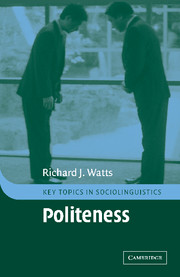Book contents
- Frontmatter
- Contents
- Preface
- 1 Introducing linguistic politeness
- 2 Politeness through time and across cultures
- 3 Modelling linguistic politeness (I)
- 4 Modelling linguistic politeness (II): Brown and Levinson and their critics
- 5 Facework and linguistic politeness
- 6 A social model of politeness
- 7 Structures of linguistic politeness
- 8 Relevance Theory and concepts of power
- 9 Politic behaviour and politeness in discourse
- 10 Politic behaviour and politeness within a theory of social practice
- Notes
- Glossary of terms
- References
- Index
7 - Structures of linguistic politeness
Published online by Cambridge University Press: 24 November 2009
- Frontmatter
- Contents
- Preface
- 1 Introducing linguistic politeness
- 2 Politeness through time and across cultures
- 3 Modelling linguistic politeness (I)
- 4 Modelling linguistic politeness (II): Brown and Levinson and their critics
- 5 Facework and linguistic politeness
- 6 A social model of politeness
- 7 Structures of linguistic politeness
- 8 Relevance Theory and concepts of power
- 9 Politic behaviour and politeness in discourse
- 10 Politic behaviour and politeness within a theory of social practice
- Notes
- Glossary of terms
- References
- Index
Summary
FORMULAIC AND SEMI-FORMULAIC EXPRESSIONS OF LINGUISTIC POLITENESS
Chapter 6 presented a new approach to the study of (im)politeness that focuses more on the perceptions of politeness made by interactants in social practice than on (im)politeness as a theoretical term in a universal model of (im)politeness. In the latter type of model a range of linguistic expressions have routinely been put forward in the literature as examples of linguistic politeness. However, if the approach outlined in chapter 6 adequately accounts for the discursive struggle over (im)politeness, it follows that no linguistic structures can be taken to be inherently polite. In the present chapter I will focus on this problem. My aim will be to demonstrate that, at least in English, linguistic structures do not in themselves denote politeness, but rather that they lend themselves to individual interpretation as ‘polite’ in instances of ongoing verbal interaction.
In order to show that no linguistic structures are inherently polite, I will need to introduce a number of new terms. These will be explained as the chapter progresses, but definitions may also be found in the glossary. I shall begin by making a distinction between what I call formulaic, ritualised utterances and semi-formulaic utterances.
I define formulaic, ritualised utterances as follows:
highly conventionalised utterances, containing linguistic expressions that are used in ritualised forms of verbal interaction and have been reduced from fully grammatical structures to the status of extra-sentential markers of politic behaviour. They have little or no internal syntactico-semantic structure.
- Type
- Chapter
- Information
- Politeness , pp. 168 - 200Publisher: Cambridge University PressPrint publication year: 2003

